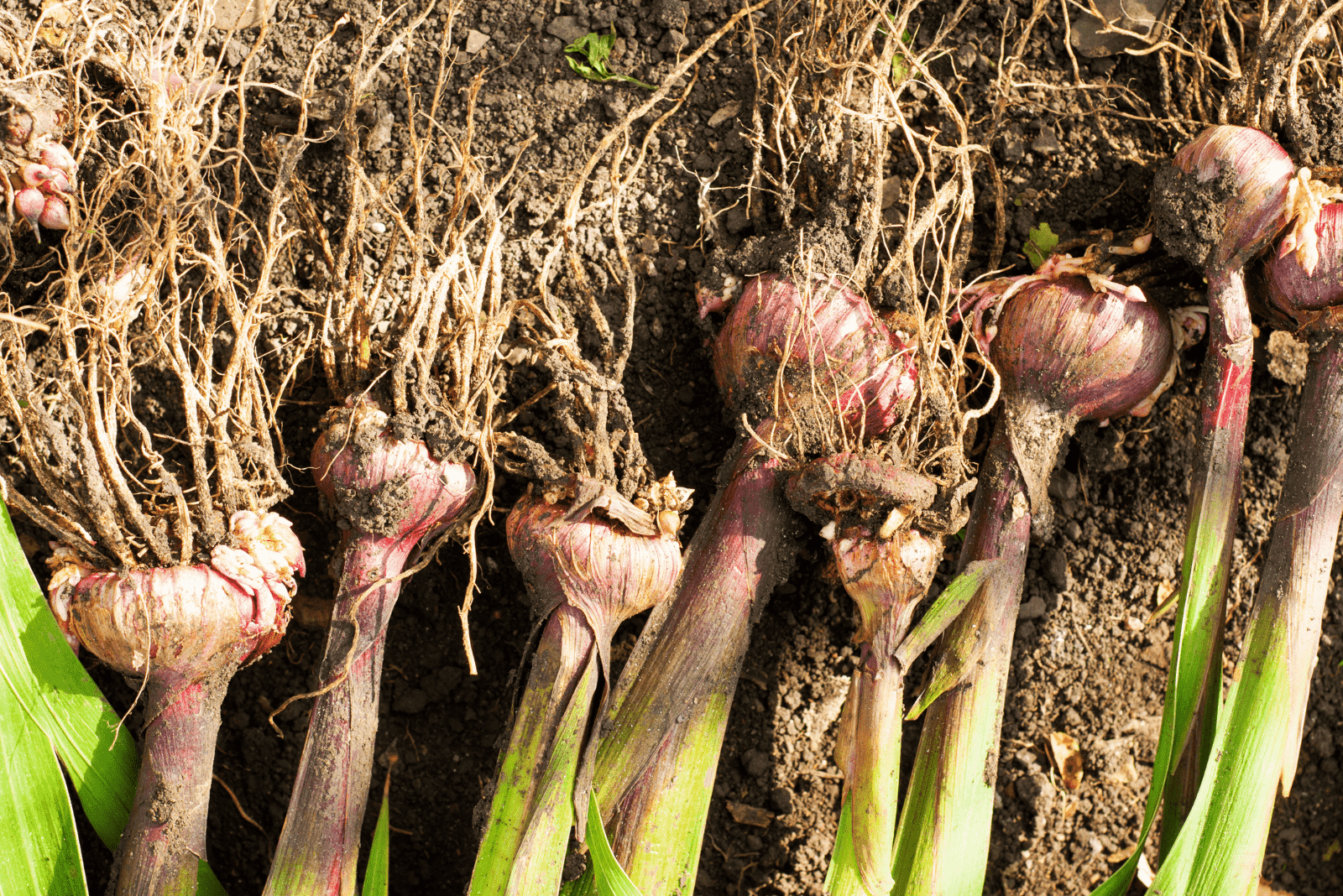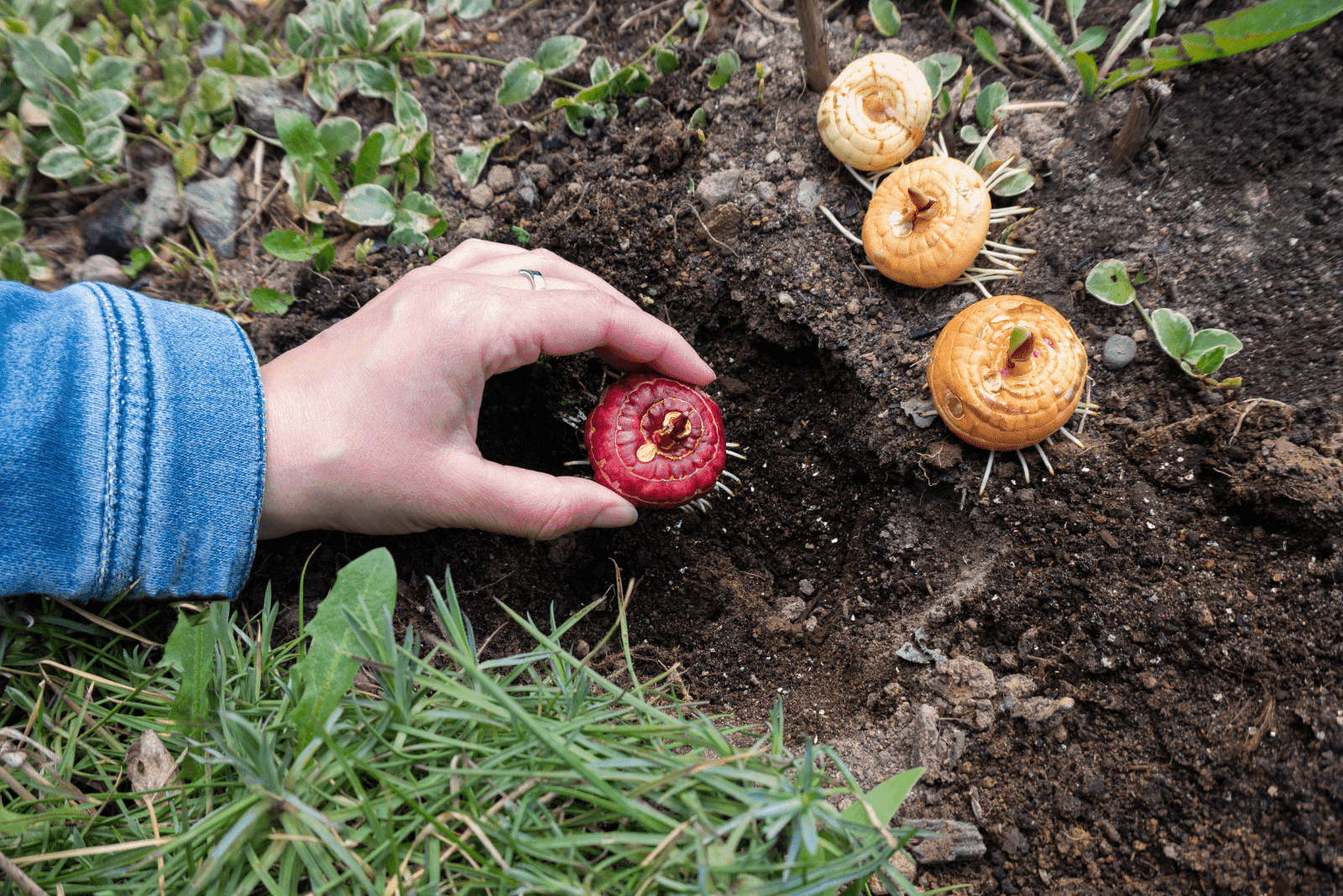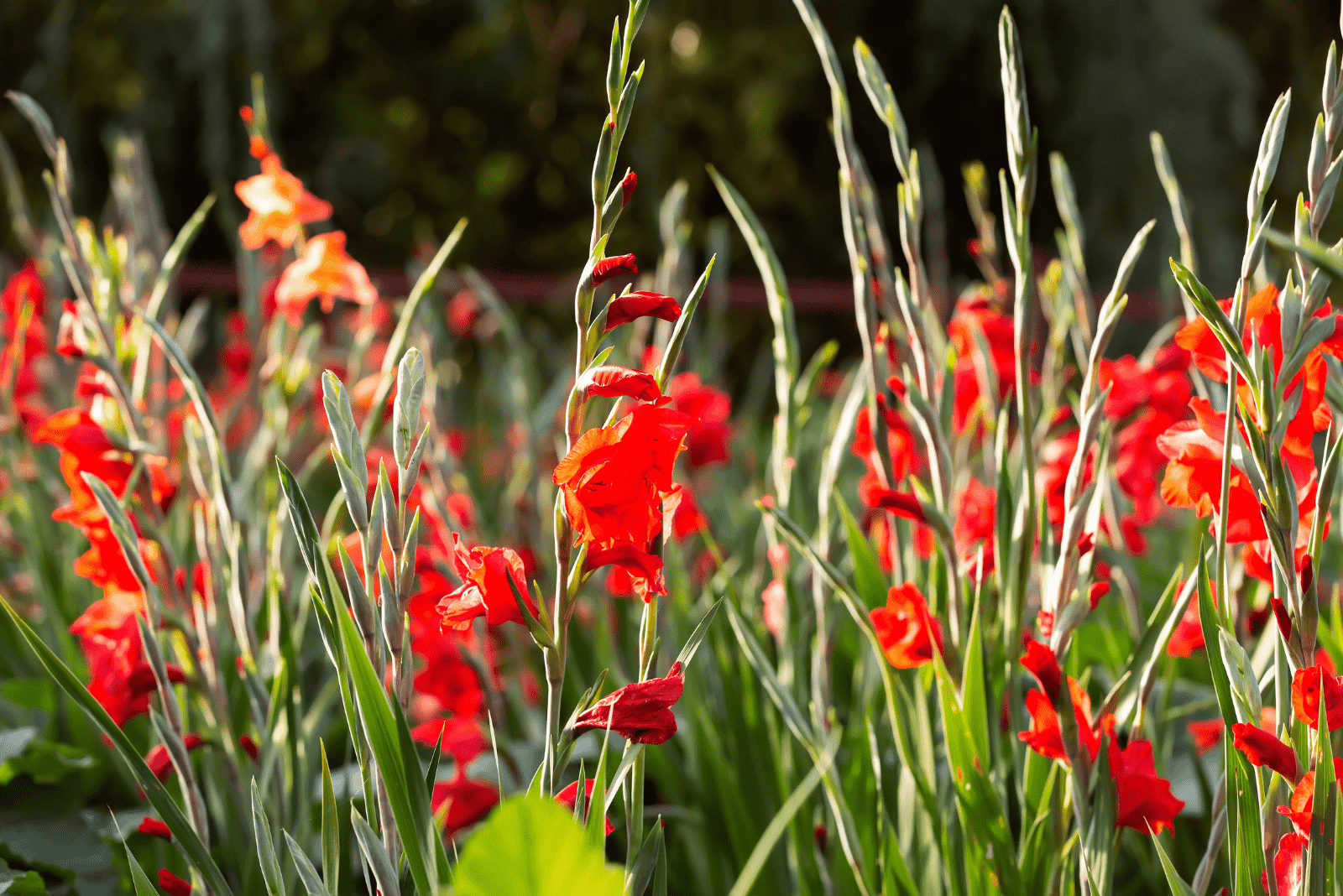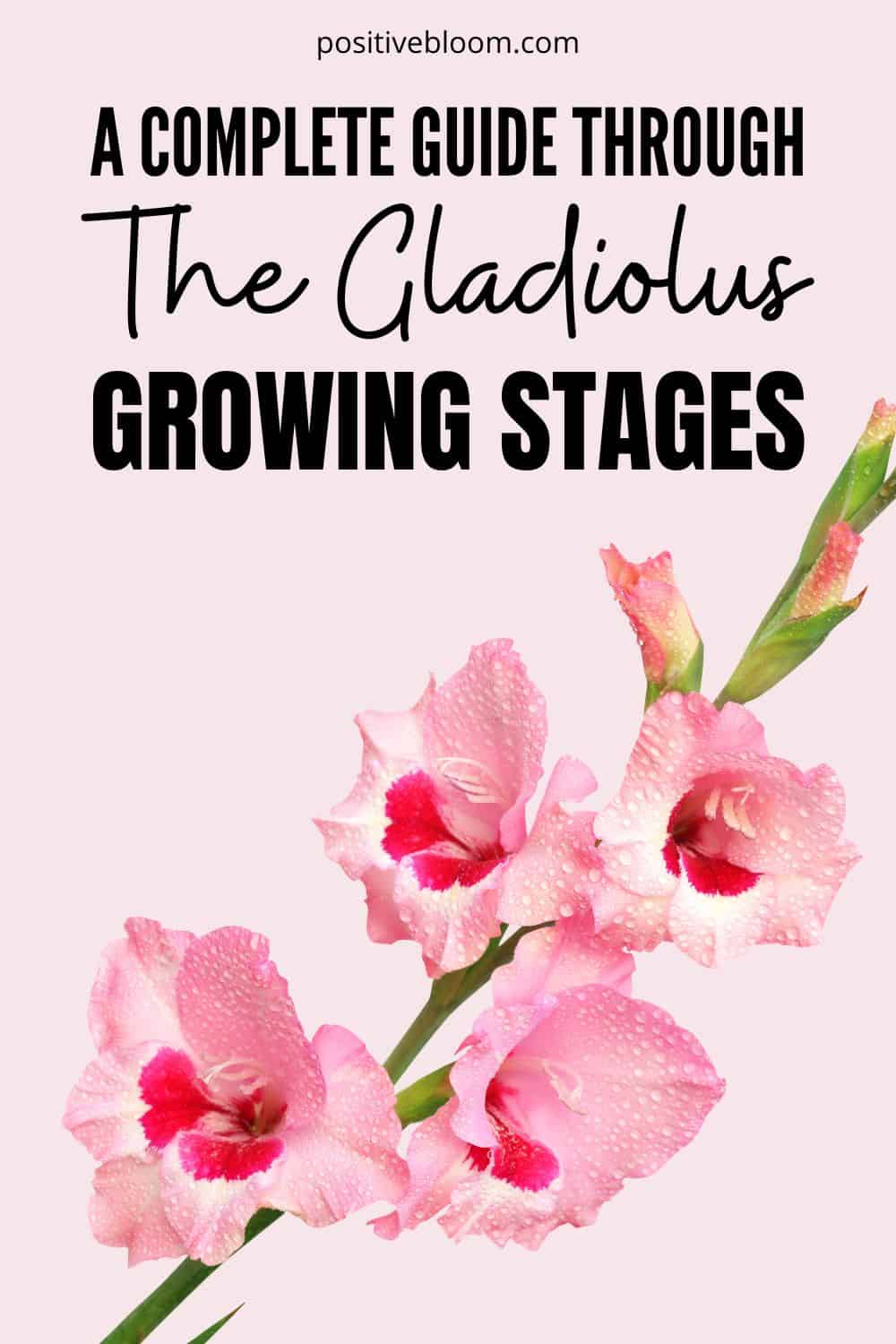The Gladiolus is an excellent choice if you want to add a beautiful and low-maintenance plant to your flower garden. The trumpet-shaped gladiolus flowers make every garden prettier, and they come in various colors.
If you decide to grow these plants in your garden, you must know the gladiolus growing stages and what to expect from each stage.
You will need to ensure all the necessary conditions during each growth stage for your glads to flourish.
In this article, I’ll tell you more about the growth stages of this plant, and also about the gladiolus care requirements.
Let’s start with some basic info about these plants:
[table id=466 /]
Gladiolus Growing Stages
The growth stages of gladiolus plants include corm development, foliage production, leaf and stem development, flowering, deadheading, and rejuvenation.
Let’s see more details about each stage.
Corm Development
Corm development is the initial stage of gladiolus growth. Everything starts with the formation of a tuber on the shoot’s end. The tuber will progressively grow and transform into a corm.
Once the corm is developed enough, it starts forming roots. The roots will secure the plant in the potting soil and ensure adequate water and nutrients for developing other plant parts.
Your glads will benefit from additional water during this growth stage. However, be careful not to overwater your gladioli because the corms are susceptible to rotting.
You can feed the plant at this point using a balanced fertilizer to promote growth.
Foliage Production Stage
The second gladiolus growing stage is the foliage production stage. When the leaves start to poke through the soil, you are witnessing new growth.
The leaf growth stage is crucial because it marks the beginning of the formation of the food producing organs of the glad.
If you are cultivating these plants for cut flowers, it’s essential to give them a boost. I recommend adding mulch to protect the plant from weeds and keep the soil moist.
Your glads need enough water and food to enter the next growth stage.
Leaf And Stem Development
Gladiolus stems typically reach 4 feet long, and a single stem can have 4 to 6 leaves. The elongated, slender leaves are an eye-catching shade of green at this stage.
You’ll notice that new leaves frequently start to emerge from the stem tips of the glad. Interestingly, you can determine the age of gladioli in their natural habitat by the number of leaves they have. Mature gladioli may produce up to 24 leaves, whereas juvenile plants may produce about 6.
Gladioli require space for both the expansion of their roots and the development of their stems and leaves. Therefore, you shouldn’t plant gladiolus corms too close together – a distance of 6 to 8 inches will suffice.
A balanced 10 10 10 fertilizer will help the newly developed plant grow healthier and become stronger.
Flowering
Once the leaves and stems develop enough, your glad will enter the blooming stage. I’m sure you’ll love this stage the most – I know I do! I’m enchanted every time I see these plants bloom.
Different gladiolus varieties have different flower colors. These plants can produce pink, yellow, white, purple, green, orange, and red flowers on tall flower spikes. For instance, Acidanthera species produce lovely white blossoms.
Each flower stalk produces up to 8 flowers.
These plants bloom in early summer, but if you plant them in spring, you can also see the flowers in late summer.
The blooms should be removed once the plant has completed flowering so that the glads can prepare for next year.
Deadheading
Your glads will produce more flowers if you cut off any dead flowers, but the plant still needs enough water and food.
If you live in a windy area, gladioli tend to fall over, so staking them is a great way to protect them from strong winds.
Check your glads regularly because some pests may infest them. Thrips are the most common pests that affect sword lilies.
Rejuvenation
If you grow these amazing plants, you’ll need to rejuvenate them every 3-5 years.
To accomplish this, you need to eliminate all the leaves and replant the corms (often referred to as gladiolus bulbs).
You can plant the corms right after you dig them up; the essential thing is to keep your corms moist.
The corms can stay in the soil and grow new roots, but only in warmer regions.
Why do glads need rejuvenation? It helps them generate larger flowers during the growing season. Additionally, you’ll protect your sword lilies from insects and diseases.
Once you replant the corms, you’ll need to give them enough water and feed them with a balanced 10 10 10 fertilizer.
New gladioli growth will be visible in a couple of weeks.
Tips For Planting And Growing Gladioli
Glads make a great addition to flower gardens, and look incredible in bouquets – but you can’t expect them to thrive if you don’t provide them with all the necessary conditions.
First, you need to pay a lot of attention to planting gladioli, and then you need to encourage growth until bloom time.
Let’s learn how to keep glads healthy and happy!
Planting Gladioli
Before planting your glads, you must find a perfect spot and prepare the soil. Regarding the spot, make sure it receives at least 6 hours of direct sunlight daily.
You can use a tiller or a garden fork to loosen the soil; sword lilies do best if their soil is deep enough. Tilling 14 to 15 inches deep should suffice.
Here are our recommendations for tillers to break new ground.
After tilling, it would be best if you add a layer of mulch or compost to provide nutrients to the soil.
Remember, the bigger the corm, the larger the flowers. I recommend planting sword lily new corms that are about an inch in diameter.
Corms perform best if planted around 4 inches deep. Make sure there is approximately 6-8 inches between each corm.
You can plant them in rows or groups. Rows are a better option if you plant the corms in a cutting garden. If planting glads near other flowering plants or in a vegetable garden, grouping them is a better option.
Staking will be necessary if you decide on growing taller sword lilies. Use caution when staking so as not to harm the corms.
Growing Gladioli
Full sun is ideal for these plants, but if that isn’t possible they will still bloom in partial shade.
What makes these plants great is that they can thrive in any well-drained soil. A layer of mulch will provide enough moisture.
Deep watering is necessary after planting, and you can continue watering approximately once a week. Don’t water too frequently because overwatering can damage the root system and lead to rotting.
Sword lilies are spring-planted bulbs that won’t bloom earlier if you plant them too early. Nighttime temperatures should be at least 60 degrees Fahrenheit.
Overwintering
These plants are winter-hardy in USDA zone 8. Once the leaves fade after the first frost, you need to dig up the corms if you live in USDA zones 7 and lower.
In milder climates, light frost won’t kill the entire plant – just the leaves. In colder climates, frost will most likely kill the entire plant, so digging up the corms is necessary.
How To Store The Corms
After digging up the corms, you need to leave them to dry. Remove the soil from your corms and place them in trays.
Keep your corms in a warm spot for about two weeks, and then remove the cormels. Apply fungicide to the corms to prevent diseases.
Put your corms in a dark place with low humidity and a temperature range of 35 to 45 degrees Fahrenheit.
That’s it; new florets of these popular Greek flowers will adorn your flower beds next year!
FAQs
What is the difference between a gladiolus and a dahlia?
Gladiolus and dahlias are spring-planted and summer-flowering bulbs, but they are entirely different plants. The first difference is in their taxonomy.
Glads belong to the Iridaceae family, whereas dahlias come from the Asteraceae family. Dahlias are native to North and Central America, and gladioli originally grew in South Africa and Europe.
Dahlia flowers resemble daisies and have one row of petals. Dahlias have peony-like flowers and contain two or more rows of petals surrounding the center.
On the other hand, gladioli produce flowers that resemble trumpets on the flower stems.
What color is a gladiolus?
There are many gladiolus varieties, and they come in a wide range of colors. For instance, the flowers of the Jester gladiolus feature yellow petals with dark red centers. The White Prosperity gladiolus has completely white flowers, and the Prince of Orange variety features flowers with various shades of orange.
Wrapping Up
I highly recommend growing gladioli as they are pretty easy to maintain and look beautiful.
Now that you know the gladiolus growing stages, you can cultivate these amazing plants in your flower garden and promote their growth using our tips.
I’m sure you’ll enjoy planting and growing these plants; you’ll undoubtedly most enjoy watching your garden filled with colorful flowers.
Until next time!
Like this post? Share or pin it for later!






